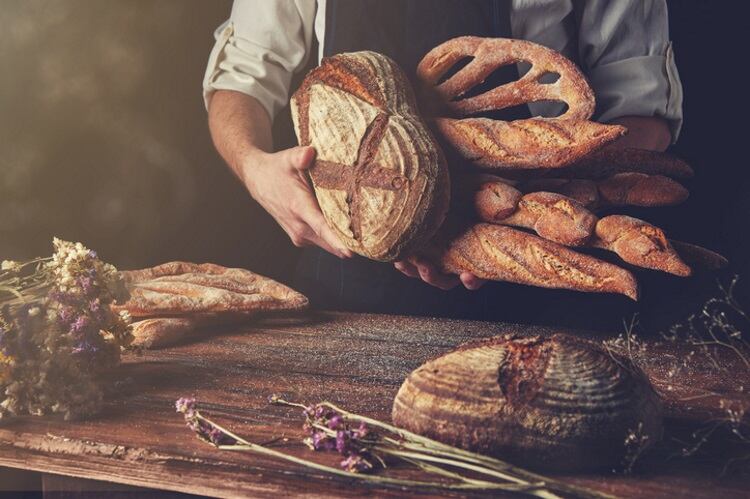
Food trends come and go faster than the seasons, but one type of food has remained a staple of the human diet for at least 4,000 years – bread.
In 2016, global consumption of bread and baked goods increased to 129,000 tons from 122,000 tons in 2007, according to IndexBox.
Specifically in Asia Pacific, rapid urbanization, increased disposable income and demand for convenient food products were estimated to drive more than $3bn in growth for bread and rolls from 2016-2020, added Technavio.
While bakeries that churn out soft buns prevail in the region, the rise of health-conscious eaters and a preference for Western-style foods have led to an increase in the popularity of artisan breads such as sourdough and rye loaves.
According to Mintel, there has been an increase in the quantity of sourdough products produced in Asia Pacific: The number of sourdough product launches in the region jumped from 25 in 2017 to 73 in 2018, driven primarily by mature markets such as Japan and Australia.
What does this mean for the bread manufacturing industry in Asia?
To understand its implications, we must dive into various components of consumer insights and the appeal of artisan bread.
Back to basics
From indulgent chocolate croissants to sweet red bean or salted egg yolk buns, Asian consumers today are spoiled for choice when it comes to bread options. However, thanks to the healthy eating movement, more consumers have inclined towards better quality, minimally processed, natural breads.
According to a 2015 Nielsen report, 39% of Asian consumers are eating fewer processed foods while 43% consider ‘all-natural’ food product claims as an important factor in purchasing decisions.
This is consistent with consumer trends in other parts of the world: For example, consumer surveys in 2016 and 2017 showed that Americans are moving away from baked bread products with sugars and additives, such as cellulose and phosphates.
Similarly, consumers in the UK and Russia have increased preferences for breads with natural positioning, such as artisan breads, as it is associated with freshness and better taste.
Bread pairing
The preference for sourdough and other artisan breads is also attributed to increased popularity for dining out and the growth in coffee culture, which usually involves the pairing of artisan breads with coffee or tea beverages.
In 2016, a global F&B report by Cushman & Wakefield reported Asian consumers spent a staggering $1,052bn on eating out, making up 32% of global consumer spending for that category.
Thanks to the rising popularity of coffee culture, café-hopping – a term used to describe when one patronizes multiple cafés – has also become a popular pastime for many millennials.
Many specialty coffee houses are popping up to cater to this burgeoning demand as a result, and Mergers Alliance market analysts have forecasted the coffee & tea F&B business will have strong average annual growth of sales of 7.2% between 2017 and 2020.
To cater to the growing demand for artisan breads, big chain bakeries across Asia have ventured towards the artisan space, and this is increasingly reflected in the quantity and variety of European-style breads offered in newly launched products and the packaged bread aisle.
For example, in Singapore, some industrial bakers have launched a range of country loaves that are improved with sourdough. These Western-style bakeries, in turn, also help to drive growth for artisanal breads through increased presence and competitive pricing.
It’s all in the yeast
Besides its natural positioning, what is the appeal of artisan breads?
True to their name, artisan breads are distinguished by their special, exclusive and sometimes, gourmet qualities, which consumers find attractive. Unlike commercial loaves, artisan bread usually requires longer hours of labor to produce, and typically have unique flavors and textures.
As it turns out, yeast and bacteria are central to the artisan breads’ unique properties.
It works by fermenting sugars to produce carbon dioxide, which allows the dough to rise and gives the bread a spongy, light texture, while the byproducts of the fermentation process give breads their unique flavors and aroma.
Healthier option
Sourdoughs are also winning hearts because of their touted health benefits, which are also credited to yeast.
Firstly, the long fermentation process in breadmaking allows the gluten and starches to be broken down, giving it a lower glycemic index (GI) than regular baked breads.
Secondly, the use of sourdough creates optimum conditions for activating enzymes that break down phytates, compounds that can bind to dietary minerals like iron and zinc and slows down absorption. This helps to promote the absorption of minerals and reduce digestive discomfort.
Bakers who are looking to provide reduced salt bread options could also turn to sourdough. Taste and flavor from sourdough enhance the aromatic profiles of bread, which allows salt reduction by 10%-20%, keeping high attractivity to the breads produced.
Sourdough usage could also help to reduce the production of acrylamide – a carcinogenic compound commonly found in baked products – by 20%-75%.
In a survey conducted by Food Industry Asia, 72% of Singapore-based food industry respondents are motivated to reformulate their products to cater to consumer demand for healthier food options, but many said they face challenges in maintaining taste and consumer acceptability in the reformulated products, as well as limitations to technical knowledge.
To answer this call, various baking ingredient companies are increasingly conducting research and innovating new solutions to help manufacturers make bread efficiently without compromising on the health or taste of the yeast.
For example, Lesaffre has produced Livendo, a range of live active sourdoughs that enable bakers to get straight into the preparation phase without having to worry about factors such as culture, wheat storage conditions and flour characteristics that may affect the fermenting power of yeasts.
Looking ahead
The sourdough market is set to grow globally at a CAGR of 8% between 2018 to 2022, according to Technavio.
With consumer demand increasing for artisan breads, the bread industry has had to take a step back in time to provide breads created from a simple sourdough recipe that has been passed down through the generations.
For yeast and baking solution manufacturers, this means the need to innovate yeast ferment offerings to help breadmakers in their task.
Study
Sourdough microbial community dynamics: An analysis during French organic bread-making processes
Authors: Emilie Lhomme, Charlotte Urien, Judith Legrand, et al
Food Microbiology, Volume 53, Part A, February 2016, Pages 41-50
https://www.sciencedirect.com/science/article/pii/S0740002014002925?via%3Dihub

